Road Diets and Safety
The City of Little Rock wants to make our streets safer and more welcoming for all users. The Arkansas Department of Transportation is focused on eliminating traffic fatalities on Arkansas' roads. Road diets can be a powerful, proven tool to make progress Toward Zero Deaths. Road diets reduce overall crash rates by 19-47% and also reduce crash severity (pgs. 5-10 and Appendix A). How?
This safety discussion will be referencing perhaps the most common road diet, the "4-to-3" road diet, however there are other types of road diets that also improve road safety and function (Fig. 1).

Figure 1. A "4-to-3" road diet. in which four lanes (two vehicular travel lanes in each direction) are converted to three lanes (one vehicular travel lane in each direction and a shared left turn lane), allowing space for bikes (or for other uses). Image from Road Diet: Common Questions and Answers.
Road Diets Improve Safety for People in Cars
1) Reduces Rear End Collisions

Figure 2. Four lane roads regularly create a condition that can cause a rear-end collision. Image from bike.lacity.org.
In a four-lane road, the interior travel lanes double as left turn lanes (Fig. 2, left). Cars stop in the interior travel lane (typically the faster travel lane) as they wait for oncoming traffic to clear before turning. If the driver in the blue car is not paying attention, this can result in a rear-end collision. A road diet allows the left-turning car to exit the travel lane, preventing this conflict (Fig. 2, right).
2) Reduces Side Swipes
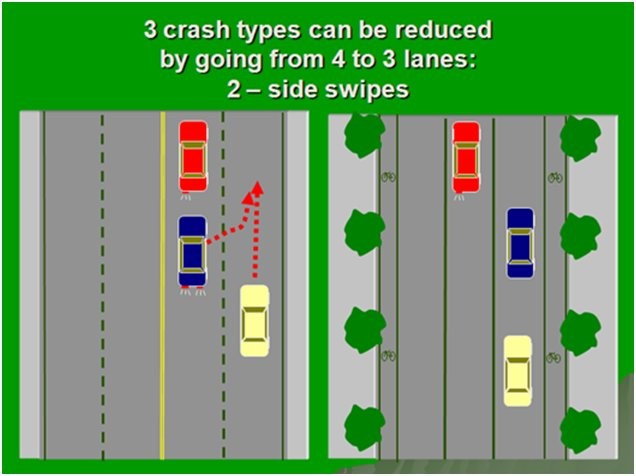
Figure 3. Four lane roads encourage lane changes to avoid waiting behind a left-turning car. Image from bike.lacity.org.
When the blue car approaches the red car, the blue driver can either stop and wait for the red car to make the turn and then proceed (and hope she doesn't get rear-ended in the meantime), or she can merge into the right travel lane (Fig. 3, left). A lane configuration that encourages frequent lane changes increases the odds of a collision. The added danger is that this is not a lane change the blue driver planned for but is a reaction to the red car. The reactive nature of this movement may increase the likelihood that the blue car driver will merge into the right lane without scanning the lane or checking her blind spot and collide with the white car. A road diet allows the left-turning red car to exit the travel lane, preventing this conflict (Fig. 3, right).
3) Eliminates Induced Blind Spots When Turning Left
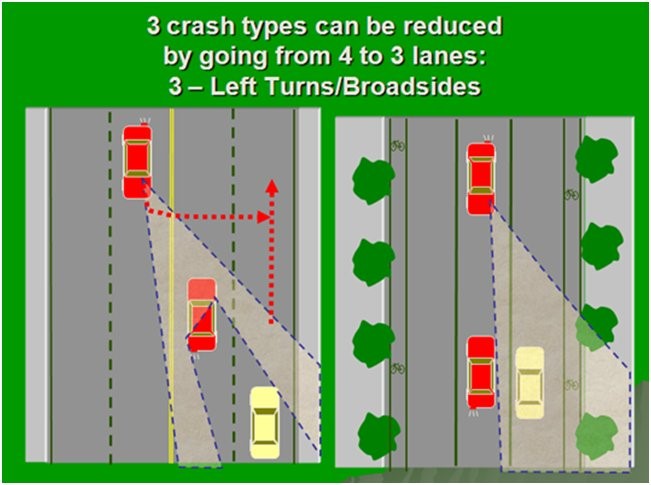
Figure 4. Four lane roads can create a blind spot for a left-turning vehicle that can result in a collision. Image from bike.lacity.org.
When a left-turning car must cross two lanes of oncoming traffic, an oncoming vehicle in the left travel lane can block the line of sight to an oncoming vehicle in the right travel lane (Fig. 4, left). This can result in the left-turning car turning into the white car. A road diet eliminates one of the oncoming lanes and thereby the line of sight conflict (Fig. 4, right).
4) Reduces Speeding
Reducing vehicular speeds decreases crash risk (Fig. 5) and crash severity (Fig. 6). In a four lane road, driver speed is unlimited by lane configuration because drivers can pass vehicles by changing into the other travel lane going in the same direction. Drivers often exceed the posted speed limit on four lane roads (Fig. 7). After a road diet, speeds are better regulated by prudent drivers because a driver cannot pass a car moving at the posted speed limit. Road diets have reduced speeding rates on Chicago's 55th St. (pg. 10), Pasadena's Cordova St. (pg. 16), and Santa Monica's Ocean Park Blvd (pg. 18) among others.

Figure 5. As cars travel faster than average traffic speed, their risk for a collision increases exponentially. Figure from SWOV's The Relationship Between Speed and Crashes.
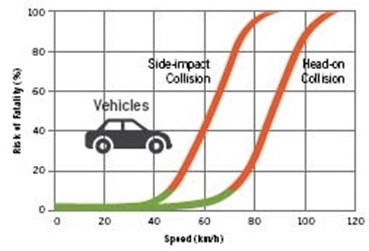
Figure 6. As vehicular speeds involved in a crash increase, the risk of a fatal injury increases logistically. Figure from South Australia's Toward Zero Together.
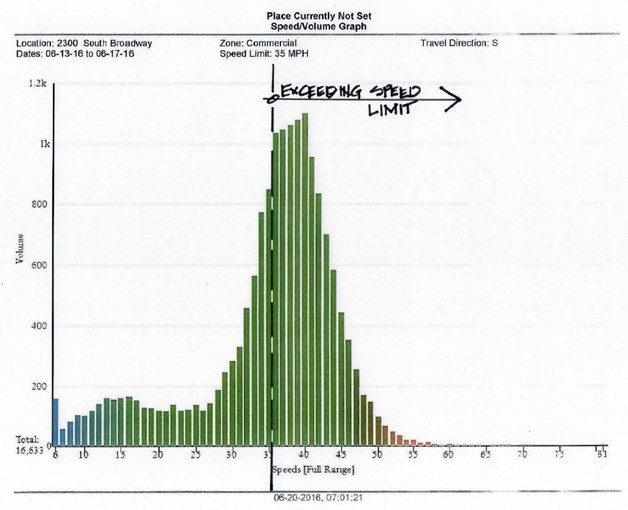
Figure 7. A histogram of the speeds on South Broadway St. (a four lane street being considered for a road diet) show that drivers typically exceed the speed limit on this street (image courtesy of Edward Sergeant).
5) Reduces Speed Differentials
Not only does absolute speed affect safety, but so do the differences in speeds between vehicles (pg. 7). A four lane road creates speed differentials by requiring vehicles to stop in a travel lane to make a left-hand turn (#1 and #2 above). A road diet that includes a left turn lane eliminates this situation.
Four lane roads also enable drivers to drive significantly faster than the speed of traffic by weaving between the two travel lanes moving in the same direction. The frequent, high-speed lane changes required to navigate around slower cars dramatically increase crash risk. On a street with a road diet, not only does the prudent driver regulate top speed (#4 above), but the inability to pass reduces speed differential.
Road Diets Improve Safety for People on Bikes and on Foot
Improving the safety of our streets is important for all users, but perhaps particularly important for people on bike and on foot. Car vs. bike and car vs. pedestrian collisions are relatively rare in the Little Rock metro area but account for 12% of our traffic fatalities. People on foot or on bike are disproportionately affected by a collision with a car because of the relative masses involved in the crash (pg. 2). Additionally, someone on a bicycle or walking does not have the protections of a modern motor vehicle (iron cage, crumple zones, seat belts, airbags, etc.). This is why people on bikes and on foot are considered "vulnerable road users".
Smart Growth America designated the Little Rock metro area as the 14th most dangerous place to walk in the country. It is imperative that we protect our vulnerable road users to both increase the safety of our community and encourage active transportation. How do road diets protect vulnerable road users?
1) Reduced Vehicular Speeds
While this is the same road diet outcome as #4 above, it also impacts people on bikes and on foot. Just as Figure 5 above shows, crash risk increases with vehicular speed due to shared dangers such as increasing stopping sight distance (Fig. 8).
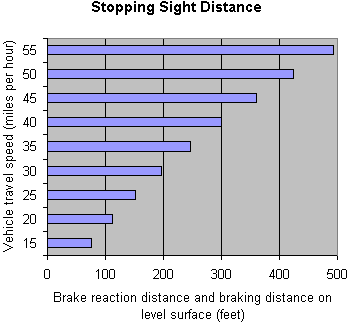
Figure 8. As vehicular speed increases, the distance the vehicle needs to come to a stop increases due to the distance traveled in the time it takes the driver to react and the inertia of the car once the brakes are applied. Image from saferoutesinfo.org.
As vehicular speed increases, people on bike and on foot are at particular risk of not being seen by a driver. This is because the driver's field of vision narrows as her speed increases (Fig. 9). Pedestrians and bicyclists are, by design, using the right side of the street and just off the street. Therefore, vehicular speed disproportionately affects driver awareness of people on bikes and on foot.

Figure 9. As vehicular speeds increase, drivers become less aware of people on bikes and on foot. Image from lgc.org.
Vehicular speed not only affects crash risk, but it also affects crash severity for vulnerable road users (Fig. 10). 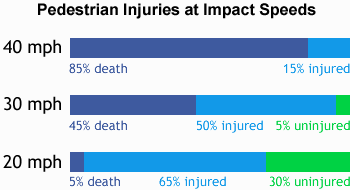
Figure 10. Pedestrian fatality risk increases dramatically as vehicular speed increases. Four lane roads often have speed limits between 30 and 40 mph. The range of speeds in this figure illustrate the utility of preventing speeding on four lane roads in order to save lives. Figure from saferouteinfo.org.
2) Creating Space for People on Bikes
A four lane road is particularly unwelcoming to someone riding a bike. Where should someone ride on our four lane roads? Little Rock ordinance requires that the rider ride as far to the right side of the roadway as is practicable, but what does that mean in this context? The lanes of four lane roads are often narrow. If the person on the bike rides to the right of the right lane, drivers attempt to pass the bicycle without changing lanes, do not give the bicycle the legally required three feet of clearance, and may cause a collision (Fig. 11, left). If the person on the bike rides in the middle of the right lane (Fig. 10, right), drivers change lanes to pass but the speed differential between bike and car (#5 above) can create a bike vs. car rear end collision (#1 above) or a car vs. car side swipe (#2 above).
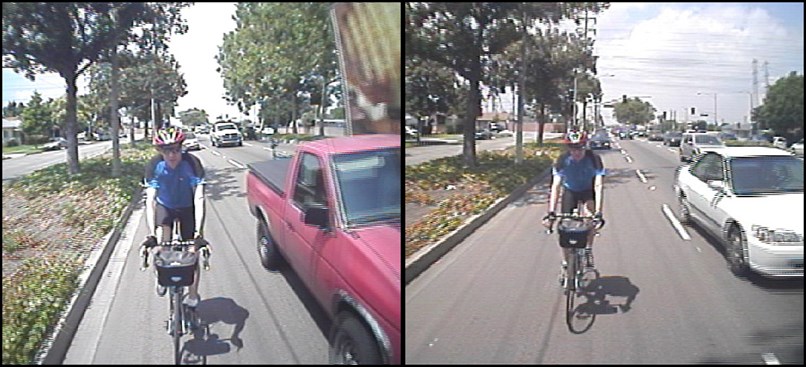
Figure 11. A four lane road offers no safe place for a bicycle (images from iamtraffic.org).
A road diet that changes a four lane road into a three lane road typically creates 10-14 ft. of "extra" road width. That space can be used to create wider shoulders (a.k.a. fog lanes), street parking on one side of the street, or standard, buffered, or protected bike lanes on both sides of the street (Fig. 12). Creating space on the road for bicycles benefits drivers by reducing speed differentials in their travel lanes and benefits people on bikes by creating a safer, dedicated space for them on the roadway.
Even if a road diet does not include bike lanes, a three lane configuration allows drivers to encroach into the left turn lane when passing a bicycle, giving the person on the bike more space (pg. 10). Bike lanes have been shown to increase safety and ridership and thus increase physical activity and community health.
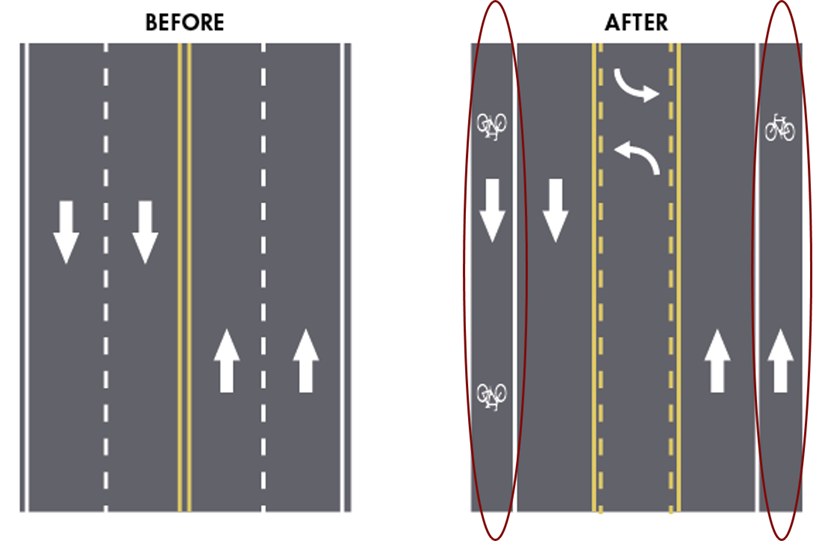
Figure 12. Road diets increase safety in a variety of ways, but may have their strongest impact on safety when the "extra" road width is used to create bike facilities (image modified from US DOT's Road Diet - Common Questions and Answers).
3) Makes Walking Across the Street Safer
A three lane street is much safer to cross than a four lane street. This is intuitive when pedestrians must cross the street without the benefit of a crosswalk (Figs. 13 and 14). On a four lane street, the pedestrian must choose a time when she will be able to cross all four lanes of traffic when vehicles speeds and sight lines may make this difficult or impossible to judge (Fig. 13). A three lane street has only two lanes of traffic to time instead of four and, if necessary, the pedestrian can use the middle turn lane as an ad hoc refuge island (Fig. 14).
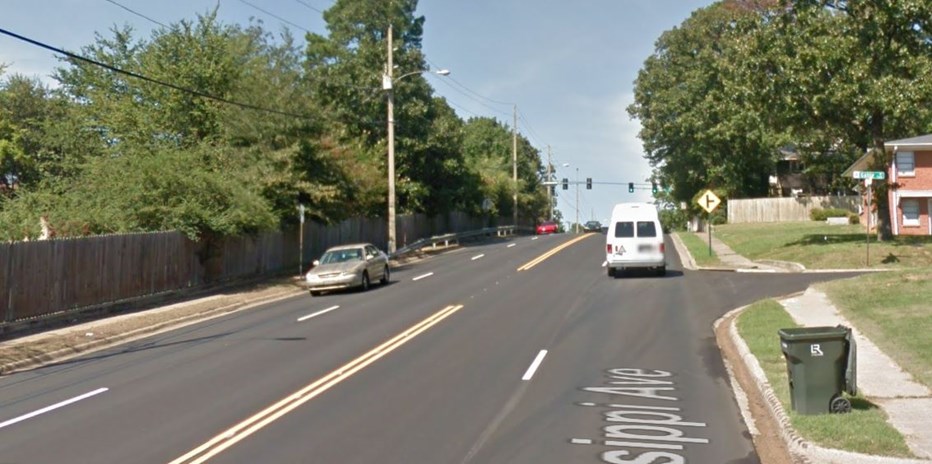
Figure 13. A four lane street is daunting for a pedestrian to cross (intersection of Mississippi Ave. and Gable Dr.).
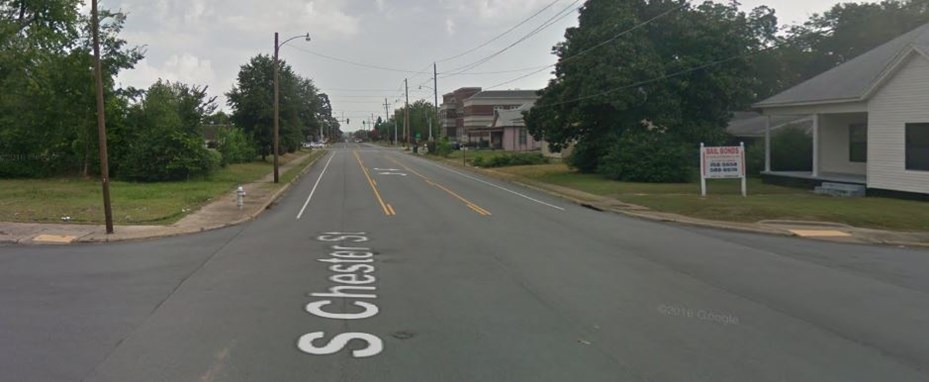
Figure 14. A three lane street is much safer for a pedestrian to cross. (S. Chester and 15th St. where the City of Little Rock recently implemented a road diet).
Crossing a four lane street at an uncontrolled crosswalk is also more dangerous than a three lane crosswalk, both for the reasons stated above and also because of sightline obstructions (Fig. 15). Arkansas is a "yield state", meaning that cars are required to yield to pedestrians in a crosswalk but pedestrians are required to yield to cars outside of crosswalks. In a four lane crosswalk, a car yielding to the pedestrian crossing the street may obscure the pedestrian and the car approaching in the interior traffic lane (Fig. 15). This situation is avoided in a three lane configuration.
This safety benefit for pedestrian crossing isn't only intuitively true considering Figs. 13-15, but, overall, two and three lane streets have been shown to be safer for pedestrians to cross than four lane streets by empirical data (pg. 9).
Figure 15. On a four lane street, the car yielding to the pedestrian in the crosswalk can obscure the pedestrian and an approaching car in the interior travel lane, causing a collision (PedBikeInfo).
4) Makes Walking Along the Street Safer
Road diets can create a buffer between vehicular traffic and the street edge, whether that is a fog lane, a bike lane, or a lane of parked cars. This benefit is particularly valuable when there is no greenspace between the sidewalk and the traffic lane (Fig. 16), especially when the sidewalk has obstructions that a pedestrian must navigate (Fig. 17).

Figure 16. Even on a curb-separated sidewalk in good repair, walking immediately abreast high speed traffic can be intimidating to pedestrians. A bike lane creates 5+ ft. of space between motor vehicles and pedestrians.
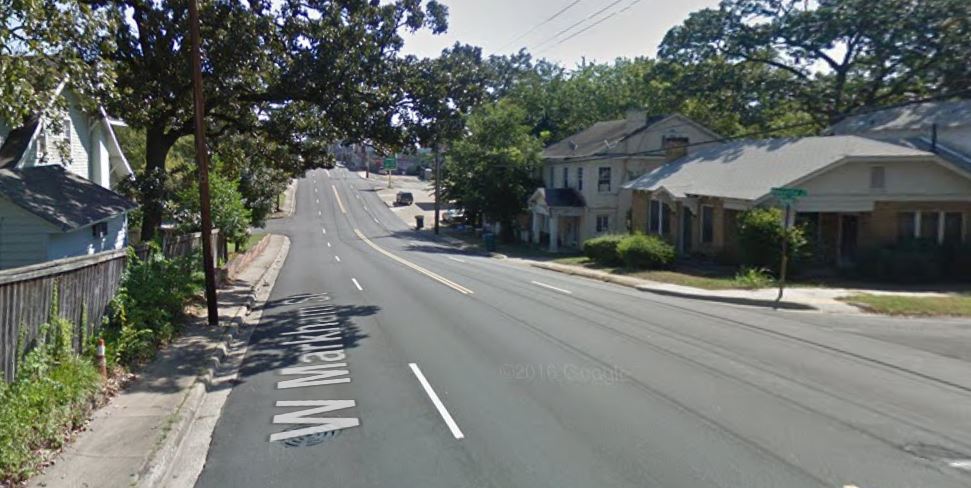
Figure 17. While W. Markham St. between the Hillcrest and Stifft Station neighborhoods has sidewalks on both sides, they are rarely used because they are narrow, interrupted by utility poles, and have no greenspace between sidewalks and vehicular traffic (corner of W. Markham and Rosetta St.). A road diet that simply installed bike lanes would improve this corridor for pedestrians (allowing them to step off of the curb and into the bike lane to get around utility poles), but it would not make the corridor ADA compliant.
Road Diets Improve Safety for Neighborhoods
Streets exist in the context of neighborhoods. How a street is designed not only affects its efficiency to move cars through an area or to access properties, but also affects the safety and community of the area in which it's located. Streets are or abut our shared space around which neighbors meet, residents manage their yards, businesses attract pedestrians to storefronts, and kids play (Fig. 18). The quality and safety of these shared spaces influence our perception of communities and how we interact with others.
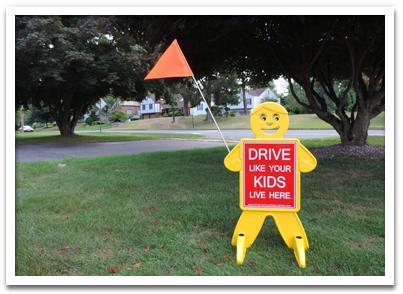
Figure 18. Road diets and informational campaigns can work together to make neighborhoods safer. Image from drivelikeyourkidslivehere.com.
Many of the pedestrian fatalities reported in Metroplan's Pedestrian/Bicyclist Crash Analysis 2015 are not from pedestrians using the roadway for transportation or even attempting to cross the street, but from living along the street (Fig. 19).
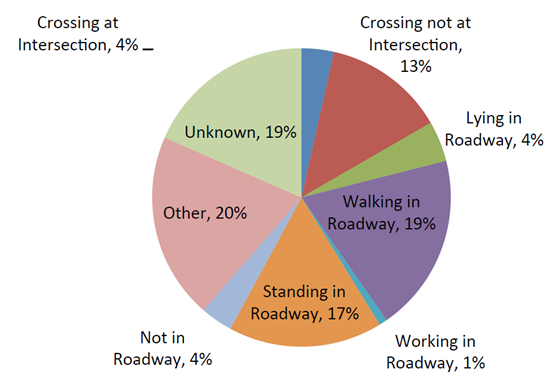
Figure 19. Many "pedestrians" killed in the Little Rock metro area were residents of neighborhoods not using the street for transportation but living in its context (image is Fig. 15 from Pedestrian/Bicyclist Crash Analysis 2015).




 Trash & Recycling
Trash & Recycling
 Online Payments
Online Payments
 City Documents
City Documents
 Parks
Parks
 Traffic Court
Traffic Court
 E-NEWS
E-NEWS
 EXPLORE
EXPLORE
 NEWS
NEWS
 TRANSLATE
TRANSLATE
